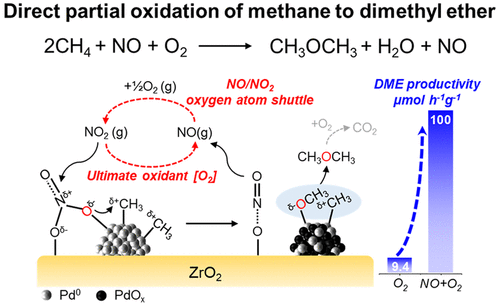Ghampson博士が中心となって行ったTed Oyama先生との共同研究の成果がACS Catalysis (ACS)にAcceptされました。Our collaboration with Prof. Ted Oyama was accepted in ACS Catalysis (ACS).
「Effect of Support and Pd Cluster Size on Catalytic Methane Partial Oxidation to Dimethyl Ether Using an NO/O2 Shuttle」Ghampson, Isaac Tyrone; Yun, Gwang-Nam; Kaneko, Arisa; Vargheese, Vibin; Bando, Kyoko; Shishido, Tetsuya; Oyama, Shigeo Ted
ACS Catalysis, 2022, 12, . DOI: 10.1021/acscatal.2c02887
The partial oxidation of methane to dimethyl ether (DME) was studied on palladium supported on SiO2, SiO2-ZrO2, and ZrO2 at 225-375 °C and 0.1 MPa using either O2 or a mixture of NO and O2 as the oxidants. The NO + O2 mixture was more reactive than the O2 toward methane, probably due to the formation of active surface nitrate species. The formation of DME on the catalysts was influenced by the support, with the Pd/ZrO2 catalyst producing DME and the Pd/SiO2 catalyst producing only CO2, irrespective of the oxidant used. The Pd/SiZrO2 catalyst formed DME only when O2 alone was used as the oxidant. For the reaction with NO + O2, in situ Fourier transform infrared (FTIR) measurements showed that the partial oxidation activity on Pd/ZrO2 was related to its ability to form surface-bridged nitrate species, likely due to the presence of basic sites. However, an inhibitory effect of basicity on CH4 turnover frequency (TOF) was attributed to surface nitrate-induced structural modification deduced from X-ray absorption fine structure spectroscopy measurements. For the reaction with only O2, the formation of DME over Pd/ZrO2 and Pd/SiZrO2 was attributed to the reported ability of ZrO2 to retain methoxy intermediates. Furthermore, a weak structural effect on the TOF observed with O2 was attributed to competing effects of decreasing activity for C-H activation and increasing resistance to Pd oxidation with increasing particle size.
